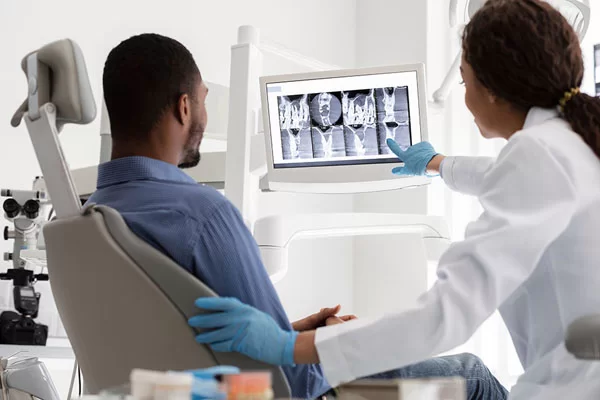Are You Experiencing Gum Disease Symptoms? Find Expert Care Near You
Gum disease affects millions of Americans, making it one of the most common oral health conditions. If you’re searching for gum disease symptoms near you or periodontal disease treatment in Holyoke, you’ve come to the right place. Our experienced dental team provides comprehensive gum disease treatment to help you maintain healthy gums and preserve your natural teeth.
Experiencing gum disease symptoms? Call our Holyoke dental office today at (413) 538-7400 for immediate care. We proudly serve patients in Holyoke, Westfield, Southampton, South Hadley, and throughout Greater Springfield with advanced periodontal therapy.
Early Signs of Gum Disease
Red, Swollen, and Tender Gums
Healthy gums should appear pale pink and feel firm to the touch. If your gums show any of these warning signs, it’s time to seek professional dental care:
- Redness and Inflammation: When bacteria accumulate along the gum line, they trigger an inflammatory response. This causes increased blood flow to the infected area, resulting in the characteristic red appearance that signals early gum disease.
- Tenderness and Sensitivity: Advanced gum disease makes your gum tissue sensitive and painful. You may experience discomfort during routine brushing and flossing or even while eating certain foods.
- Gum Swelling: Infected gum tissue becomes puffy and swollen, often appearing larger than usual. In severe cases, swollen gums may protrude between your teeth, affecting both function and appearance.
Bleeding Gums
Bleeding gums are among the most common early signs of gum disease and should never be ignored:
- Bleeding during oral hygiene: Healthy gums don’t bleed when you brush or floss. If you notice blood on your toothbrush or dental floss, schedule an appointment with a dentist near you immediately.
- Spontaneous bleeding: In advanced cases, gums may bleed without stimulation. You might notice blood on your pillow in the morning or during normal activities.
- Persistent bleeding: Gum disease-related bleeding continues over time and won’t resolve without proper treatment from a qualified dental professional.
Gum Recession
Periodontal disease causes gum tissue to recede, creating pockets where harmful bacteria can accumulate and multiply:
- Exposed Root Surfaces: As gums recede, tooth roots become visible, making teeth appear longer and creating sensitivity to hot, cold, and sweet stimuli.
- Spaces Between Teeth: Receding gums can cause gaps to appear between teeth, affecting both the appearance of your smile and your bite alignment.
- Increased Tooth Sensitivity: Exposed root surfaces lack the protective enamel coating found on tooth crowns, leading to increased sensitivity and discomfort.
Gum Disease Symptoms
Loose Teeth and Tooth Loss
When gum disease progresses to advanced periodontitis, it can cause significant damage to the supporting structures of your teeth:
- Bone loss: The bacteria responsible for periodontal disease attack and destroy the underlying bone that supports your natural teeth
- Tooth mobility: As bone support diminishes, teeth may become loose or shift position
- Changes in bite alignment: Mobile teeth can alter how your upper and lower teeth fit together when you bite down
Persistent Bad Breath (Halitosis)
Bad breath from gum disease occurs due to:
- Bacterial buildup: Accumulated plaque releases volatile sulfur compounds with distinctly unpleasant odors
- Gum infection: Active infection in gum tissue creates an environment where bacteria continue producing foul-smelling gases
- Poor oral hygiene: Inadequate brushing and flossing allow food particles and bacteria to decompose in the mouth
Pus Between Teeth and Gums
In severe cases of advanced gum disease, you may notice pus formation:
- Gum abscess: Deep pockets between teeth and gums can become infected, leading to localized abscesses
- Accumulation of infection: Pus consists of dead bacteria, inflammatory cells, and tissue debris
- Foul taste: The presence of pus often creates an unpleasant taste in your mouth
Gum Disease Risk Factors
Lifestyle Factors
- Poor Oral Hygiene: Failing to maintain proper brushing and flossing habits leads to plaque and tartar buildup, the primary cause of gum disease.
- Tobacco Use: Smoking and chewing tobacco significantly increase gum disease risk by reducing blood flow to gum tissue and compromising your body’s ability to fight infection.
- Poor Nutrition: Diets high in sugar and carbohydrates promote harmful bacterial growth in your mouth, while inadequate nutrition weakens your immune system’s ability to combat gum disease.
Medical Conditions and Medications
- Diabetes: People with diabetes face a higher risk of gum disease due to compromised immune function and increased susceptibility to infections.
- Hormonal Changes: Women experience increased gum disease risk during pregnancy, menstruation, and menopause due to hormonal fluctuations that affect gum tissue.
- Medications: Certain medications, including antidepressants and heart medications, can cause dry mouth, reducing the saliva’s natural protective effects.
Genetic and Age-Related Factors
- Family History: Genetics plays a role in gum disease susceptibility, with some individuals naturally more prone to developing periodontal problems.
- Age: Older adults face an increased risk, especially when combined with poor oral hygiene habits or other health conditions.
Modern Gum Disease Treatment Options in Holyoke, MA
Non-Surgical Treatments
- Professional Dental Cleaning: Regular professional cleanings remove plaque and tartar buildup that brushing and flossing alone can’t eliminate.
- Scaling and Root Planing: This deep cleaning procedure, also called periodontal therapy, removes bacteria and infected tissue from below the gum line and smooths root surfaces to prevent future bacterial attachment.
- Antibiotic Therapy: Targeted antibiotics can help eliminate bacterial infections in gum pockets when used alongside mechanical treatments.
Advanced Treatment Options
- Laser-Assisted Periodontal Therapy: Laser-assisted periodontal therapy has gained popularity due to its precision and reduced patient discomfort. Techniques like the LANAP (Laser-Assisted New Attachment Procedure) protocol use specific wavelengths of light to target diseased tissue while preserving healthy gum tissue.
- Regenerative Procedures: Researchers are making significant strides in regenerative techniques. One of the most promising areas is stem cell therapy. Scientists are harnessing the power of stem cells to regenerate bone and gum tissues, showing incredible potential in early studies.
- Bone Grafting: For patients who have experienced bone loss due to advanced periodontitis, bone grafting procedures can help restore lost bone structure and support dental implants if needed.
Preventing Gum Disease: Your Defense Against Periodontal Problems
The best defense against gum disease starts with proper oral hygiene and regular professional care:
- Proper Brushing Technique: Brush your teeth twice daily using fluoride toothpaste and a soft-bristled toothbrush. Focus on gentle, circular motions along the gum line.
- Daily Flossing: Flossing removes plaque and food particles from between teeth and below the gum line where your toothbrush can’t reach.
- Antimicrobial Mouthwash: Use an antimicrobial mouthwash to help reduce bacteria and freshen breath.
- Regular Dental Visits: Schedule dental cleanings and checkups every six months, or more frequently if recommended by your dentist.
- Early Detection: Regular dental examinations allow for early detection of gum disease when it’s most treatable.
- Personalized Treatment Plans: Your dentist can develop a customized treatment plan based on your specific risk factors and oral health needs.
Frequently Asked Questions
When selecting a dentist in Holyoke for gum disease treatment, look for:
- Experience with periodontal therapy and advanced treatments
- Modern equipment and treatment techniques
- Positive patient reviews from local residents
- Convenient location and flexible scheduling
- Acceptance of your dental insurance
In its early stages (gingivitis), gum disease can often be completely reversed with improved oral hygiene and professional dental care. However, advanced periodontitis causes permanent damage to gum tissue and bone. The goal of treatment becomes managing the condition to prevent further progression and maintain your natural teeth.
Most patients benefit from dental cleanings and checkups every six months. However, if you have risk factors for gum disease or a history of periodontal problems, your dentist may recommend more frequent visits. Patients with active gum disease may need professional cleanings every three to four months during the initial treatment phase.
While good oral hygiene is essential, natural remedies alone cannot cure established gum disease. Professional dental treatment is necessary to effectively remove bacteria and infected tissue. Some natural approaches that may complement professional care include:
- Oil pulling with coconut oil
- Saltwater rinses
- Green tea consumption
- Aloe vera gel application
Always consult with your dentist before relying on natural remedies, as delayed professional treatment can lead to tooth loss.
Take Action Today: Protect Your Oral and Overall Health
Don’t wait until gum disease symptoms worsen. Early detection and treatment are crucial for maintaining healthy gums and preserving your natural teeth. If you’re experiencing any signs of gum disease or if it’s been more than six months since your last dental cleaning, schedule an appointment today.
Ready to improve your gum health? Call our Holyoke dental office at (413) 538-7400 to schedule your comprehensive periodontal evaluation. Our experienced team provides personalized gum disease treatment using the latest techniques and technology.
We proudly serve patients throughout Holyoke, Westfield, Southampton, South Hadley, and Greater Springfield with compassionate, high-quality dental care. Your healthy smile is our priority, and we’re here to help you achieve optimal oral health for life.


